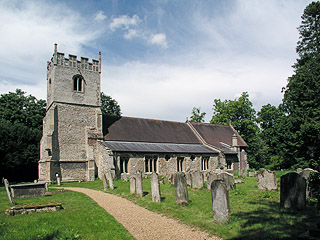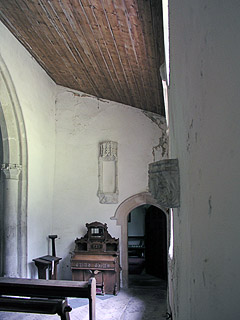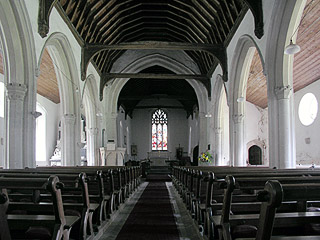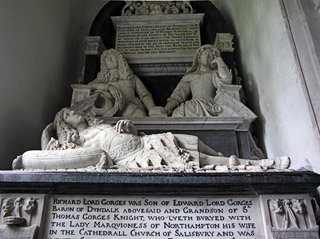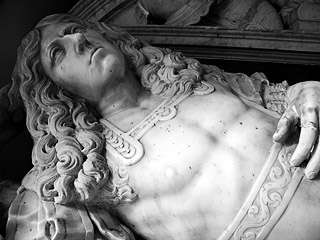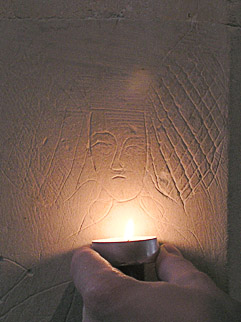St Peter sits in a verdant churchyard, surrounded by great mature beech trees and the breeding stables of the great and good (on the electoral roll for the parish council are the 7th Duke and Duchess of Sutherland and their son the Marquis of Stafford).
This is very close to Newmarket, and the landscape is very odd - lots of huge paddocks and straight roads running between avenues of trees. It all felt a little bit like we were driving through an unused landscape from Alice in Wonderland.
St Peter itself is a rather strange little church. The first thing I noticed was the peculiar jumble of windows in the aisles. Some are square-headed Tudor ones, but there are also two quatrefoils in each aisle. They are so unusual that I'm tempted to agree with Pevsner, who says that they're 19th century.
Also peculiar is the lack of a porch, since the churchyard is obviously on the edge of a great park. Instead, the entry is through a small door in the 14th century west tower. This is small, but quite elegant. There are diagonal buttresses that are patched up with brick towards the top, and the faces are covered with rather gnarled cement. The parapet is flushwork, and the stone remains from a flushwork base course - Suffolk style asserting its presence, perhaps. The corners of the tower are decorated with four little pyramids topped with balls, which must be a later addition.
Inside, the church felt nicely undisturbed - here, the Victorian restoration was surprisingly lenient. Take, for example, the roof, where they reused the original timbers and corbels. The latter are carved to depict faces and shields and things. Talking of woodwork, I also liked the screen separating the tower from the nave - the lower part is classical, with some y-tracery above.
Most of the nave is 14th century, though it's thought that the tower arch might have been rebuilt in the 15th century. The arcades are quite an unusual design - they are thinner than they are long, with the short sides facing into the nave and continuous with the wall above. Within the arches are octagonal semi-piers, complete with battlements on the capitals from which an inner moulded arch springs. A similar (though rather grander) design can be seen at Harston, across the county.
I did wander up and have a look at the chancel, but there's not much to say about it. It is the oldest bit of the church - dating from the 13th century - and I'm sure the lancets are original. The glass, though, is not: and it makes the space rather gloomy.
Thankfully there are much more interesting things to see in the nave aisles. In the south, for example, is a niche set in the wall - the bracket sits on top of a little angel with a very flat face, carrying a book. The niche itself is vaulted.
The most interesting things are in the north aisle. First, there are two brackets for statues on the piers in the north arcade, which are unusual. Second, there's a magnificent tomb at the east end. This is to Henry, Lord Gorges, the son of Richard, Baron of Dundalk. The story behind it is rather sad: Richard and his wife Beatrice had two sons. One (Edward) died in infancy, and Henry who is commemorated here died in 1664 at the tender age of 19. He reclines on a chest, resting on a cushion and wearing extremely camp Restoration faux-Roman armour and a vast periwig.
He looks extremely fashionable and rather ridiculous, which makes his early death all the more poignant. Above him, resting on bits of broken pediment are the upper bodies of his grieving parents. Baron Richard has a very pinched nose and his face is completely dwarfed by another vast periwig, and he holds the hand of Lady Bridget. The carving is all magnificent quality - much better than anything else of the period I've seen in the county. [Mark adds: I disagree, there are some excellent tomb statues in the county - although this is certainly as good as anything else. The 'roman' armour and periwig are quite amazing, I have a weakness for periwigs as is well known to my friends...].
An inscription below gives more information about Baron Richard, and it explains why his son should have so grand a tomb. Richard was for over twenty years the Superintendent and Surveyor General for the draining of the Great Level of the Fens - called the Bedford Level after the Duke of Bedford who paid for the vast undertaking. Richard's commission started in 1656, and so he would have been in post when his son died - hence the burial here, I suppose, despite the Gorges being a Somerset family.
Finally, following directions in the guide, we found various bits and bobs of graffiti in the north arcade. On the west side of the piers, out of sight of the vicar, various bored parishioners have left their mark in the soft stone.
In several places there are geometrical patterns formed by taking two fixed points (like a compass) and scratching circles. These vary from simple six-petalled flowers to much more complicated overlapping swirls and spheres. There are also a few figures. On the middle pier there is an image of a man wearing tights and a tunic with fashionably slit sleeves, carrying a sword and what looks like a wand. Next to him, something that could be a cat or a devil leers at us from a square.
On the next pillar to the east are the strangest things of all. There is the face of a very stern-looking woman, complete with an elaborate headdress. Evidently the artist was pleased with their handiwork, for just below they have scratched an owl, also wearing an elaborate headdress! Like the woman, the owl has a very pinched severe looking face - indeed, so striking was the resemblance that it made me wonder if this was a medieval satire.
We have no way of knowing who the woman is, of course, but we can appreciate the joke - and suddenly, five hundred years doesn't seem like such a long time at all.
St Peter is kept locked, but there are keyholders listed.
